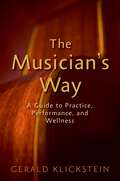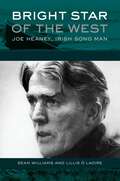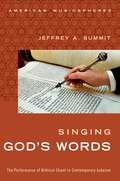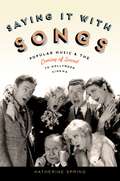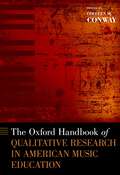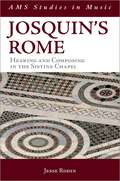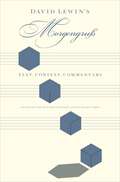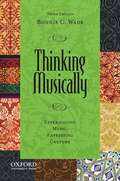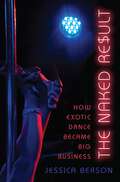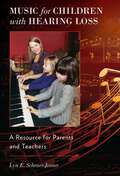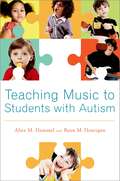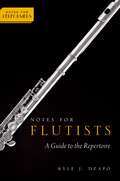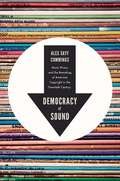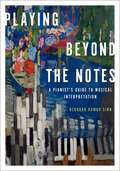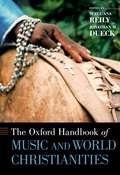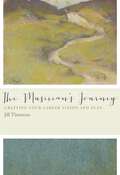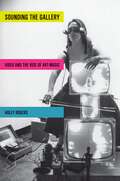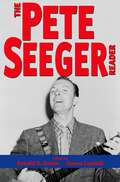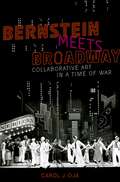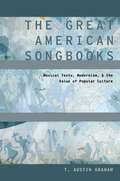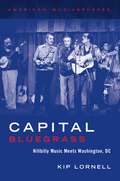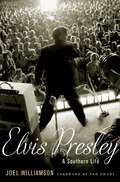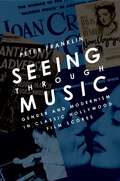- Table View
- List View
The Musician's Way: A Guide to Practice, Performance, and Wellness
by Gerald KlicksteinIn The Musician's Way, veteran performer and educator Gerald Klickstein combines the latest research with his 30 years of professional experience to provide aspiring musicians with a roadmap to artistic excellence. Part I, Artful Practice, describes strategies to interpret and memorize compositions, fuel motivation, collaborate, and more. Part II, Fearless Performance, lifts the lid on the hidden causes of nervousness and shows how musicians can become confident performers. Part III, Lifelong Creativity, surveys tactics to prevent music-related injuries and equips musicians to tap their own innate creativity. Written in a conversational style, The Musician's Way presents an inclusive system for all instrumentalists and vocalists to advance their musical abilities and succeed as performing artists.
Bright Star of the West: Joe Heaney, Irish Song Man (American Musicspheres)
by Sean Williams Lillis Ó LaoireBright Star of the West examines the life, repertoire, and influence of Ireland's greatest sean-nos (old-style) singer, Joe Heaney (1919-1984). Best known for popularing this form of Gaelic a cappella folk song in the United States, authors Sean Williams and Lillis Ó Laoire reveal the ways in which Heaney's life story demonstrates the intertwining of music with political memory and cultural understanding.
SINGING GOD WORDS IN GOD OWN TUNE AM C: The Performance of Biblical Chant in Contemporary Judaism (American Musicspheres)
by Jeffrey SummitSinging God's Words is the first in-depth study of the experience and meaning of chanting or "reading" Torah among contemporary American Jews. This experience has been transformed dramatically in recent years by the impact of digital technology, feminism, the empowerment of lay people and a search for self-fulfillment through involvement with community. At a time when worshippers seek deeper spiritual experience, many Jews have found new meaning in the experience of reading Torah, an act that is broadly accessible to Jewish adults even as it requires intensive immersion with the text of the Bible in Hebrew. This book examines why and how growing numbers of American Jews in all denominations see the public chanting of Biblical texts during the synagogue service as one of the most authentic and personal expressions of their religious identity. Drawing on hundreds of interviews with men and women, both professionals and congregants, Jeffrey A. Summit describes how the reading of Torah embodies their understanding of historical religious practice, even as it is shaped by contemporary views of spiritual experience. Through this act, holiness becomes manifest at the intersection of Biblical chant, sacred text, the individual, and the community.
Saying It With Songs: Popular Music and the Coming of Sound to Hollywood Cinema (Oxford Music / Media)
by Katherine SpringHollywood's conversion from silent to synchronized sound film production not only instigated the convergence of the film and music industries but also gave rise to an extraordinary period of songs in American cinema. Saying It With Songs considers how the increasing interdependence of Hollywood studios and Tin Pan Alley music publishing firms influenced the commercial and narrative functions of popular songs. While most scholarship on film music of the period focuses on adaptations of Broadway musicals, this book examines the functions of songs in a variety of non-musical genres, including melodramas, romantic comedies, Westerns, prison dramas, and action-adventure films, and shows how filmmakers tested and refined their approach to songs in order to reconcile the spectacle of song performance, the classical norms of storytelling, and the conventions of background orchestral scoring from the period of silent cinema. Written for film and music scholars alike as well as for general readers, Saying It With Songs illuminates the origins of the popular song score aesthetic of American cinema.
The Oxford Handbook of Qualitative Research in American Music Education (Oxford Handbooks)
by Colleen M. ConwayQualitative research has become increasingly popular in music education over the last decade, yet there is no source that explains the terms, approaches and issues associated with this approach. In The Oxford Handbook of Qualitative Research in American Music Education, editor Colleen Conway and the contributing music educators provide that clarification, as well as models of qualitative studies within various music education disciplines. The handbook outlines the history of qualitative research in American music education and explores the contemporary use of qualitative approaches in examining issues related to music teaching and learning. It includes 32 chapters that address a range of topics, from ways of approaching qualitative research and ways of collecting and analyzing data, to the various music teaching and learning contexts that have been studied using qualitative approaches. The final section of the book tackles permission to conduct research, teaching qualitative research, publishing qualitative research, and provides direction for the future. An ambitious and much-needed volume, this handbook will stand as a key resource for drawing meaning from the experiences of students and teachers in music classrooms and communities both in America and in other countries.
Josquin's Rome: Hearing and Composing in the Sistine Chapel (AMS Studies in Music)
by Jesse RodinIn the late fifteenth century the newly built Sistine Chapel was home to a vigorous culture of musical composition and performance. Josquin des Prez stood at its center, singing and composing for the pope's private choir. Josquin's Rome offers a new reading of the composer's work in light of the repertory he and his fellow papal singers performed from the chapel's singers' box. Comprising the single largest surviving corpus of late fifteenth-century sacred music, these pieces served as a backdrop for elaborately choreographed liturgical ceremonies--a sonic analogue to the frescoes by Botticelli, Perugino, and their contemporaries that adorn the chapel's walls. Jesse Rodin uses a comparative approach to uncover this aesthetically and intellectually rich musical tradition. He confronts longstanding problems concerning the authenticity and chronology of Josquin's music while offering nuanced readings of scandalously understudied works by the composer's contemporaries. The book further contextualizes Josquin by locating intersections between his music and the wider soundscape of the Cappella Sistina. Central to Rodin's argument is the idea that these pieces lived in performance. The author puts his interpretations into practice through a series of exquisite recordings by his ensemble, Cut Circle (available both on the companion website and as a CD from Musique en Wallonie). Josquin's Rome is an essential resource for musicologists, scholars of the Italian Renaissance, and enthusiasts of early music.
David Lewin's Morgengruß: Text, Context, Commentary
by David Bard-Schwarz Richard CohnArguably one of the most influential and revered figures in contemporary music theory, David Lewin (1933-2003) revolutionized the field through his work on transformational theory and theoretical methodology. David Lewin's Morgengruß: Text, Context, Commentary presents in print for the first time Lewin's legendary 1974 essay on Franz Schubert's "Morgengruß," from the composer's song cycle, Die Schöne Müllerin. The essay was central to Lewin's graduate teaching, and copies of it have circulated by hand through the music-scholarly community for decades. This book presents the original text of Lewin's essay along with over 200 graphical illustrations. Lewin's ability to present an artful and rich argument, based on a close reading of a short, "simple" score is but one of the wonders to behold in his masterful essay. At once deeply nuanced and widely accessible, Lewin's "Morgengruß" offers insight into Schubert's composition as well as the analytical process itself. Along with the full text of Lewin's essay, this book includes a small but pointed collection of essays interpreting the content and significance of Lewin's "Morgengruß." Drawing on current research as well as personal reflection, editors Richard Cohn and David Bard-Schwarz, along with contributors Brian Kane and Henry Klumpenhouwer, elaborate on the analytical, pedagogical, and philosophical contexts of Lewin's work. Taken together, the editors and contributors offer a compelling account of the enduring significance of Lewin's writing. David Lewin's Morgengruß is a must-have for anyone with an interest in Lewin's career, Schubert's music, or music theory generally.
Thinking Musically: Experiencing Music, Expressing Culture (pdf) (Global Music Ser.)
by Bonnie C. WadeAs the cornerstone of the Global Music Series, Thinking Musically, Third Edition, explores musical diversity by integrating the sounds and traditions of world cultures. Bonnie C. Wade discusses how various cultural influences-gender, ethnicity, mass media, westernization, nationalism, and acculturation-are shaping music and the ways that we experience it. WHAT'S NEW TO THE THIRD EDITION? * Simplified and incorporates recent additions to the Global Music Series * New charts and diagrams delve into important musical concepts * Updated companion website includes a new guide to online and print resources, a sample syllabi, and teaching tips Visit www.oup.com/us/globalmusic for a list of case studies in the Global Music Series. The website also includes instructional material to accompany each study.
Singing God's Words: The Performance of Biblical Chant in Contemporary Judaism (American Musicspheres)
by Jeffrey SummitSinging God's Words is the first in-depth study of the experience and meaning of chanting or "reading" Torah among contemporary American Jews. This experience has been transformed dramatically in recent years by the impact of digital technology, feminism, the empowerment of lay people and a search for self-fulfillment through involvement with community. At a time when worshippers seek deeper spiritual experience, many Jews have found new meaning in the experience of reading Torah, an act that is broadly accessible to Jewish adults even as it requires intensive immersion with the text of the Bible in Hebrew. This book examines why and how growing numbers of American Jews in all denominations see the public chanting of Biblical texts during the synagogue service as one of the most authentic and personal expressions of their religious identity. Drawing on hundreds of interviews with men and women, both professionals and congregants, Jeffrey A. Summit describes how the reading of Torah embodies their understanding of historical religious practice, even as it is shaped by contemporary views of spiritual experience. Through this act, holiness becomes manifest at the intersection of Biblical chant, sacred text, the individual, and the community.
The Naked Result: How Exotic Dance Became Big Business
by Jessica BersonWe have grown accustomed to corporate influence in retail outlets, restaurants, and even higher education-but what happens when corporations take over desire? The Naked Result: How Exotic Dance Became Big Business explores the changing world of striptease, tracing its path from the unruly underground to brightly lit, branded 'gentlemen's clubs.' Drawing on her own experience as an exotic dancer, Jessica Berson examines the ways that striptease embodies conflicting notions of race, class, and female sexuality, and how the exotic dance industry deploys these differences to codify and commodify our erotic imagination. Chain clubs, fitness programs, and music videos are moving exotic dance into the mainstream, stripping its historical potential to embody and express subversive desires-erotic and otherwise-and generate resistant modes of female erotic subjectivity. Through case studies including Boston's Combat Zone in the 1970s-80s, the development of lap dancing in London in the 1990s, and the triumph of corporate striptease in post-Giuliani New York City in the last decade,The Naked Result reveals an industry that increasingly eradicates individuality and agency in order to increase profits. Ultimately, The Naked Result argues that corporatization has cheerfully smothered the diversity of desire and expression for both dancers and customers, repackaging the most mysterious human emotions into easily branded experiences no more personal or powerful than those to be found in any themed restaurant or coffee mega-chain.
Music for Children with Hearing Loss: A Resource for Parents and Teachers
by Lyn Schraer-JoinerWritten by an expert in the field who is both a teacher and a teacher-educator, this book is an in-depth and practical resource for educators and parents who wish to introduce music to children with hearing loss. Author Lyn Schraer-Joiner makes a compelling case for offering music education to children with hearing loss before presenting a series of important and up-to-date teaching strategies meant to inform their educational experience, including preparations for the classroom, communication strategies for parents and teaching staff, and tips on more specific or technical matters such as conducting musical audiograms. These resources provide a solid background for hands-on instructional materials such as music lessons, supplemental activities, educational resources, discussion points, and journal samples for the classroom and home. Schraer-Joiner goes to great lengths to offer detailed, purposeful suggestions for specific classroom settings such as general music, choral ensemble, and instrumental ensemble as well as a set of recommended listening lessons that take this potential variety of settings into account. Furthermore, Schraer-Joiner provides suggestions for incorporating music into everyday activities and also presents an overview of recent research which reinforces the benefits of music upon social and emotional development as well as speech and language development. Each chapter concludes with a section entitled "For Your Consideration" which features review questions, ideas, and instructional activities that teachers and parents can accomplish with deaf and hard of hearing children. The book's "Kids Only" online component provides deaf and hard-of-hearing children with descriptions of the many opportunities available to them in the arts, inspirational case studies and stories, as well as important ideas and topics for deaf and hard-of-hearing children to consider discussing with the teachers, family members, and healthcare professionals that they work with. The message of this book is a powerful one particularly in this day and age. As hearing aid and cochlear implant technologies improve and become increasingly widespread, all teachers--especially music teachers--should expect to see more deaf and hard-of-hearing children in their classrooms. Awareness and preparation are not only vital in aiding these children in the classroom, but are in fact required of teachers by federal law. This book is a comprehensive resource for teachers and parents who wish to gain a better understanding of the emerging field of music education for students with hearing loss.
Teaching Music to Students with Autism
by Alice M. Hammel Ryan M. HouriganTeaching Music to Students with Autism is a comprehensive resource for everyone who works with students with autism within the music classroom. The authors focus on understanding autism, advocating for students and music programs, and creating and maintaining a team approach by working together with colleagues effectively. A significant portion of the book is focused on understanding and overcoming the communication, cognition, behavior, sensory, and socialization challenges inherent in working with students with autism. The authors suggest ways to structure classroom experiences and learning opportunities for all students. The book includes vignettes and classroom snapshots from experienced music teachers which provide additional opportunities to transfer theory to real-life application.
Notes for Flutists: A Guide to the Repertoire (Notes for Performers)
by Dr. Kyle DzapoNotes for Flutists: A Guide to the Repertoire offers important historical and analytical information about three dozen of the best-known pieces written for the instrument. Its contextual and theoretical insights make it an essential resource for professional, amateur, and student flutists. With engaging prose supported by fact-filled analytical charts, the book offers rich biographical information and informative analyses to help flutists gain a more complete understanding of J. S. Bach's Sonata in B minor, Reinecke's Undine Sonata, Fauré's Fantaisie, Hindemith's Sonata for Flute and Piano, Copland's Duo for Flute and Piano, and 30 other masterpieces. Offering a faithful and comprehensive guide to understanding the contexts in which the repertoire was composed, Notes for Flutists details in clear, chronological order flute repertoire from Telemann, Mozart, and Enescu to Prokofiev, Poulenc, and Muczynski. Kyle Dzapo includes biographical information on each composer and highlights history's impact on the creation and performance of important works for flute. Intended as a starting point for connecting performance studies with scholarship, Dr. Dzapo's analysis will help flutists gain a more complete picture of a given work. Its valuable insights make it essential to musicians preparing and presenting programs, and its detailed historical information about the work and composer will encourage readers to explore other works in a similarly analytical way. Covering concertos, chamber pieces, and works for solo flute, Kyle Dzapo presents Notes for Flutists, an indispensable handbook for students and professionals alike.
Democracy of Sound: Music Piracy and the Remaking of American Copyright in the Twentieth Century
by Alex Sayf CummingsIt was a time when music fans copied and traded recordings without permission. An outraged music industry pushed Congress to pass anti-piracy legislation. Yes, that time is now; it was also the era of Napster in the 1990s, of cassette tapes in the 1970s, of reel-to-reel tapes in the 1950s, even the phonograph epoch of the 1930s. Piracy, it turns out, is as old as recorded music itself. In Democracy of Sound, Alex Sayf Cummings uncovers the little-known history of music piracy and its sweeping effects on the definition of copyright in the United States. When copyright emerged, only visual material such as books and maps were thought to deserve protection; even musical compositions were not included until 1831. Once a performance could be captured on a wax cylinder or vinyl disc, profound questions arose over the meaning of intellectual property. Is only a written composition defined as a piece of art? If a singer performs a different interpretation of a song, is it a new and distinct work? Such questions have only grown more pressing with the rise of sampling and other forms of musical pastiche. Indeed, music has become the prime battleground between piracy and copyright. It is compact, making it easy to copy. And it is highly social, shared or traded through social networks--often networks that arise around music itself. But such networks also pose a counter-argument: as channels for copying and sharing sounds, they were instrumental in nourishing hip-hop and other new forms of music central to American culture today. Piracy is not always a bad thing. An insightful and often entertaining look at the history of music piracy, Democracy of Sound offers invaluable background to one of the hot-button issues involving creativity and the law.
Playing Beyond the Notes: A Pianist's Guide to Musical Interpretation
by Deborah Rambo SinnPlaying Beyond the Notes: A Pianist's Guide to Musical Interpretation demystifies the complex concepts of musical interpretation in Western tonal piano music by boiling it down to basic principles in an accessible writing style. Author and veteran piano instructor Deborah Rambo Sinn tackles a different interpretive principle, explaining clearly, for example, how to play effective ornaments and rubatos. As a whole, the book helps pianists understand concrete ways to apply interpretive concepts to their own playing and gives teachers practical ways to teach interpretation to their students. The book is illustrated with over 200 repertoire excerpts and supplemented by a companion website with over 100 audio recordings. Playing Beyond the Notes is essential reading for all performing pianists, independent piano teachers, and piano pedagogy students.
The Oxford Handbook of Music and World Christianities (Oxford Handbooks)
The Oxford Handbook of Music and World Christianities investigates music's role in everyday practice and social history across the diversity of Christian religions and practices around the globe. The volume explores Christian communities in the Americas, Europe, Africa, Asia, and Australia as sites of transmission, transformation, and creation of deeply diverse musical traditions. The book's contributors, while mostly rooted in ethnomusicology, examine Christianities and their musics in methodologically diverse ways, engaging with musical sound and structure, musical and social history, and ethnography of music and musical performance. These broad materials explore five themes: music and missions, music and religious utopias (and other oppositional religious communities), music and conflict, music and transnational flows, and music and everyday life. The volume as a whole, then, approaches Christian groups and their musics as diverse and powerful windows into the way in which music, religious ideas, capital, and power circulate (and change) between places, now and historically. It also tries to take account of the religious self-understandings of these groups, presenting Christian musical practice and exchange as encompassing and negotiating deeply felt and deeply rooted moral and cultural values. Given that the centerpiece of the volume is Christian religious musical practice, the volume reveals the active role music plays in maintaining and changing religious, moral, and cultural values in a long history of intercultural and transnational encounters.
The Musician's Journey: Crafting Your Career Vision and Plan
by Dr. Jill TimmonsThe Musician's Journey escorts musicians, performing artists, music teachers, and advanced music students along the road toward a successful career, offering a vast array of resources to guide them from envisioning the process to achieving the practical details. Jill Timmons provides key tools throughout the journey, from sources as diverse as the world of myth to current brain research, which illuminate compelling real-world examples of music entrepreneurs who forged their own paths to success. Included are chapters on careers in higher education; guidance in how to develop a business plan; general tips on grant writing and financial development; a separate section exploring the stories of other successful musicians; and personal narrative taken from the author's work as a professional musician and consultant. The book includes an extensive bibliography of additional resources, and the companion website offers downloadable worksheets and questionnaires to help readers along their way.
Sounding the Gallery: Video and the Rise of Art-Music (Oxford Music / Media)
by Holly RogersBecoming commercially available in the mid 1960s, video quickly became integral to the intense experimentalism of New York City's music and art scenes. The medium was able to record image and sound at the same time, which allowed composers to visualize their music and artists to sound their images. But as well as creating unprecedented forms of audiovisuality, video work also producedinteractive spaces that questioned conventional habits of music and art consumption. This book explores the first decade of creative video work, focusing on the ways in which video technology was used to dissolve the boundaries between art and music.
The Pete Seeger Reader (Readers on American Musicians)
by Ronald D. Cohen James CapaldiPerhaps the most widely recognized figure in folk music and one of the most well-known figures in American political activism, Pete Seeger now belongs among the icons of 20th-century American culture. The road to his current status as activist and respected voice of folk music was long and often rough, starting from the moment he dropped out of Harvard in the late 1930s and picked up a banjo. Editors Ronald Cohen and James Capaldi trace Seeger's long and storied career, focusing on his work as not only a singer, but also on his substantial contributions as an educator, songwriter, organizer, publisher, and journalist. The son of musicians, Seeger began his musical career before World War II and became well-known in the 1950s as a member of the commercially popular Weavers, only to be blacklisted by much of the mainstream media in the 1960s because of his progressive politics, and to return to the music scene in subsequent decades as a tireless educator and activist. The Pete Seeger Reader gathers writings from numerous sources, mixing Seeger's own work with that of the many people who have, over the years, written about him. Many of the pieces have never before been republished, and cover his entire career. A figure of amazing productivity, influence, and longevity, Seeger is author of a life that has been both cast in heroic terms and vilified. The selections in this book draw from a full range of these perspectives and will inform as they entertain, bringing into focus the life and contributions of one of the most influential figures of the twentieth century.
Bernstein Meets Broadway: Collaborative Art in a Time of War (Broadway Legacies)
by Carol J. OjaWinner of the 2015 Music in American Culture Award from the American Musicological Society When Leonard Bernstein first arrived in New York City, he was an unknown artist working with other brilliant twentysomethings, notably Jerome Robbins, Betty Comden, and Adolph Green. By the end of the 1940s, these artists were world famous. Their collaborations defied artistic boundaries and subtly pushed a progressive political agenda, altering the landscape of musical theater, ballet, and nightclub comedy. In Bernstein Meets Broadway: Collaborative Art in a Time of War, award-winning author and scholar Carol J. Oja examines the early days of Bernstein's career during World War II, centering around the debut in 1944 of the Broadway musical On the Town and the ballet Fancy Free. As a composer and conductor, Bernstein experienced a meteoric rise to fame, thanks in no small part to his visionary colleagues. Together, they focused on urban contemporary life and popular culture, featuring as heroes the itinerant sailors who bore the brunt of military service. They were provocative both artistically and politically. In a time of race riots and Japanese internment camps, Bernstein and his collaborators featured African American performers and a Japanese American ballerina, staging a model of racial integration. Rather than accepting traditional distinctions between high and low art, Bernstein's music was wide-open, inspired by everything from opera and jazz to cartoons. Oja shapes a wide-ranging cultural history that captures a tumultuous moment in time. Bernstein Meets Broadway is an indispensable work for fans of Broadway musicals, dance, and American performance history.
The Great American Songbooks: Musical Texts, Modernism, and the Value of Popular Culture (Modernist Literature and Culture)
by T. Austin GrahamIn the late nineteenth and early twentieth centuries, American authors pioneered a mode of musical writing that quite literally resounded beyond the printed page. Novels gained soundtracks, poetry compelled its audiences to sing, and the ostensibly silent act of reading became anything but. The Great American Songbooks is the story of this literature, at once an overview of musical and authorial practice at the century's turn, an investigation into the sensory dimensions of reading, and a meditation on the effects that the popular arts have had on literary modernism. The writings of John Dos Passos, Theodore Dreiser, T.S. Eliot, F. Scott Fitzgerald, Langston Hughes, Jean Toomer, and Walt Whitman are heard in a new key; the performers and tunesmiths who inspired them have their stories told; and the music of the past, long out of print and fashion, is recapitulated and made available in digital form. A work of criticism situated at the crossroads of literary analysis, musicology, and cultural history, The Great American Songbooks demonstrates the importance of studying fiction and poetry from interdisciplinary perspectives, and it suggests new avenues for research in the dawning age of the digital humanities.
Capital Bluegrass: Hillbilly Music Meets Washington, DC (American Musicspheres)
by Kip LornellWith its rich but underappreciated musical heritage, Washington, D.C. is often overlooked as a cradle for punk, the birthplace of go go, and as the urban center for bluegrass in the Untied States. Capital Bluegrass: Hillbilly Music Meets Washington, D.C. richly documents the history and development of bluegrass in and around the nation's capital since it emerged in the 1950s. In his seventeenth book, American vernacular music scholar Kip Lornell discusses both well-known progressive bluegrass bands including the Country Gentlemen and the Seldom Scene, and lesser known groups like the Happy Melody Boys, Benny and Vallie Cain and the Country Clan, and Foggy Bottom. Lornell focuses on colorful figures such as the brilliant and eccentric mandolin player, Buzz Busby, and Connie B. Gay, who helped found the Country Music Association in Nashville. Moving beyond the musicians to the institutions that were central to the development of the genre, Lornell brings the reader into the nationally recognized Birchmere Music Hall, and tunes in to NPR powerhouse WAMU-FM, which for five decades broadcast as much as 40 hours a week of bluegrass programming. Dozens of images illuminate the story of bluegrass in the D.C. area, photographs and flyers that will be new to even the most veteran bluegrass enthusiast. Bringing to life a music and musical community integral to the history of the city itself, Capital Bluegrass tells an essential tale of bluegrass in the United States.
Elvis Presley: A Southern Life
by Joel WilliamsonIn Elvis Presley: A Southern Life, one of the most admired Southern historians of our time takes on one of the greatest cultural icons of all time. The result is a masterpiece: a vivid, gripping biography, set against the rich backdrop of Southern society--indeed, American society--in the second half of the twentieth century. Author of The Crucible of Race and William Faulkner and Southern History, Joel Williamson is a renowned historian known for his inimitable and compelling narrative style. In this tour de force biography, he captures the drama of Presley's career set against the popular culture of the post-World War II South. Born in Tupelo, Mississippi, Presley was a contradiction, flamboyant in pegged black pants with pink stripes, yet soft-spoken, respectfully courting a decent girl from church. Then he wandered into Sun Records, and everything changed. "I was scared stiff," Elvis recalled about his first time performing on stage. "Everyone was hollering and I didn't know what they were hollering at." Girls did the hollering--at his snarl and swagger. Williamson calls it "the revolution of the Elvis girls." His fans lived in an intense moment, this generation raised by their mothers while their fathers were away at war, whose lives were transformed by an exodus from the countryside to Southern cities, a postwar culture of consumption, and a striving for upward mobility. They came of age in the era of the 1954 Brown vs. Board of Education ruling, which turned high schools into battlegrounds of race. Explosively, white girls went wild for a white man inspired by and singing black music while "wiggling" erotically. Elvis, Williamson argues, gave his female fans an opportunity to break free from straitlaced Southern society and express themselves sexually, if only for a few hours at a time. Rather than focusing on Elvis's music and the music industry, Elvis Presley: A Southern Life illuminates the zenith of his career, his period of deepest creativity, which captured a legion of fans and kept them fervently loyal for decades. Williamson shows how Elvis himself changed--and didn't. In the latter part of his career, when he performed regular gigs in Las Vegas and toured second-tier cities, he moved beyond the South to a national audience who had bought his albums and watched his movies. Yet the makeup of his fan base did not substantially change, nor did Elvis himself ever move up the Southern class ladder despite his wealth. Even as he aged and his life was cut short, he maintained his iconic status, becoming arguably larger in death than in life as droves of fans continue to pay homage to him at Graceland. Appreciative and unsparing, culturally attuned and socially revealing, Williamson's Elvis Presley will deepen our understanding of the man and his times.
Seeing Through Music: Gender and Modernism in Classic Hollywood Film Scores (Oxford Music / Media)
by Peter FranklinHollywood film music is often mocked as a disreputably 'applied' branch of the art of composition that lacks both the seriousness and the quality of the classical or late-romantic concert and operatic music from which it derives. Its composers in the 1930s and '40s were themselves often scornful of it and aspired to produce more 'serious' works that would enhance their artistic reputation. In fact the criticism of film music as slavishly descriptive or manipulatively over-emotional has a history that is older than film - it had even been directed at the relatively popular operatic and concert music written by some of the émigré Hollywood composers themselves before they had left Europe. There, as subsequently in America, such criticism was promoted by the developing project of Modernism, whose often high-minded opposition to mass culture used polarizing language that drew, intentionally or not, upon that of gender difference. Regressive, late-romantic music, the old argument ran, was -- as women were believed to be -- emotional, irrational, and lacking in logic. This book seeks to level the critical playing field between film music and "serious music," reflecting upon gender-related ideas about music and modernism as much as about film. Peter Franklin broaches the possibility of a history of twentieth-century music that would include, rather than marginalize, film music -- and, indeed, the scores of a number of the major Hollywood movies discussed here, like The Bride of Frankenstein, King Kong, Rebecca, Gone With The Wind, Citizen Kane and Psycho. In doing so, he brings more detailed music-historical knowledge to bear upon cinema music, often discussed as a unique and special product of film, and also offers conclusions about the problematic aspects of musical modernism and some arguably liberating aspects of "late-romanticism."
